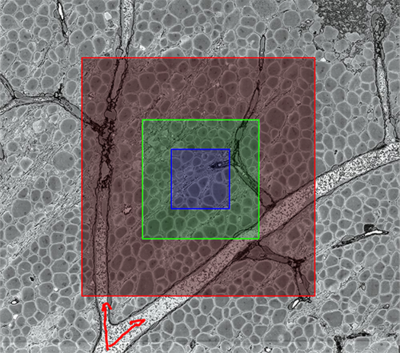Encountered in cubes
Encountered in cubes
While playing Eyewire, citizen scientists can encounter a variety of interesting and sometimes baffling phenomena, such as misalignments, black spills, and mergers. Those are explained in the wiki, in Overcoming Obstacles and Mergers.
Players can also encounter Cell Bodies of other cells we may have already mapped or are to be mapped, some we may not map, or even Capillaries, the smallest of the body's blood veins, which are huge in comparison to dendrites and may take the whole of the cube's volume.
Floating seed
One of those interesting phenomena that can be encountered while playing cubes are floaters or floating seeds. Those are seeds, originally given AI segments, that do not touch any of the cube's wall(s).
In the pictures the dark blue is the seed and the light/cyan blue is the player trace/additions.
Floating seed pieces occur if there's a jump or an especially tricky extension right where the overlap occurs between two cubes/tasks. Sometimes the AI only manages to snag the piece after the jump but nothing that touches the edge. Floaters usually happen in/around cube overlap. Wall traces are another good example to show how a tiny branch may be seeded but a whole other large branch may be missed which leaves that jagged edge look in the overview.
Players should trace those as they offer huge point rewards. Be sure to get all the extensions and nubs for great accuracy as well.
Capillaries
Capillaries are the smallest of the body's blood veins. They make up the micro-circulation of the body's circulatory system. For more information.
Capillaries can be identified in-cube by their size, huge compared to anything else in the slides except Cell Bodies, but unlike Cell Bodies they have a thick black ink outline.
Players are to avoid tracing those at all costs.



